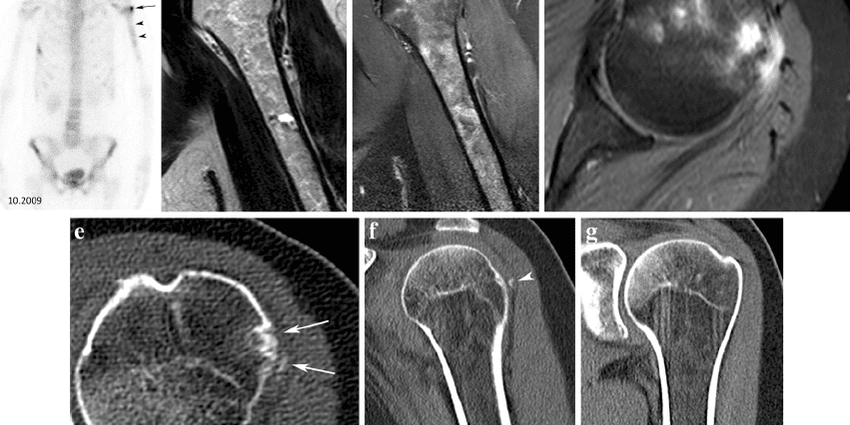Contents
- Calcification of the shoulder, bone or breast: all you need to know
- What is calcification?
- What are the causes of their presence in the tissues?
- Why is pain sometimes present when there are microcalcifications in the shoulder?
- What do calcifications in the breast mean?
- What does the presence of calcifications mean in the arteries?
- What are the other calcifications in the body?
- What are the other calcifications in the body?
Calcification of the shoulder, bone or breast: all you need to know
Many calcifications can be present in the body, sometimes discovered by chance during x-rays. They are not always a sign of underlying pathology, but sometimes require additional investigations when the clinical context suggests it. Explanations.
What is calcification?
Intra-body calcifications are small crystals of calcium salt present in various parts of the body, along the arteries, tendons, muscles, in the breast, the small pelvis. Visible on radiography, they are linked to microtrauma, chronic irritation or inflammation, excessive production of calcium by the body, an abnormal healing process or simple aging of the tissues. They do not all testify to a disease and are most often painless and discovered by chance during imaging such as x-rays, CT scans or Magnetic Resonance Imaging (MRI).
What are the causes of their presence in the tissues?
Microcalcifications can explain chronic pain such as:
- pain when moving the shoulder (tendonitis);
- be a sign of breast cancer (but not always);
- show atherosclerosis of the arteries (coronary arteries of the heart, aorta, carotids);
- an old muscle or tendon trauma.
Others have no particular pathological significance, apart from an aging of the tissues. Their presence can be painful, but more often than not, microcalcifications are not painful.
Why is pain sometimes present when there are microcalcifications in the shoulder?
The presence of calcifications in the shoulder is frequent, because it concerns 10% of the population. It is not always associated with pain, but in the presence of shoulder pain during movement and calcifications, the diagnosis of calcifying tendonitis can be made.
The pain is related to the irritation of the tendon during movements by microcalcifications, that of the bursa above the tendon of the shoulder (fluid pocket) or the friction of the tendon on the ligaments and the bone in this region. (acromion).
This calcifying tendonitis can heal spontaneously in 12 or 16 months. But after exploration by imaging, it sometimes requires a local intervention to remove the calcifications (shock waves to split the calcifications, intervention in the shoulder joint by crushing and removing the calcifications).
What do calcifications in the breast mean?
Calcifications in the breast (s) are quite common and most are unrelated to cancer. They appear as small white masses or small white dots (microcalcifications) on X-ray images. Fairly common in women over 50, they can be linked to several factors.
Calcifications in the form of small, irregular white masses
These can be related to:
- Aging of the arteries;
- Healing of breast contusions during an accident for example;
- Treatments for breast cancer including surgery and radiation therapy
- Infection of breast tissue (mastitis);
- Non-cancerous masses such as adenofibroma or cysts.
For microcalcifications: possible breast cancer, especially if they appear in the form of clusters.
The doctor may order a new mammogram with localized compression, a biopsy or a new mammogram in 6 months.
What does the presence of calcifications mean in the arteries?
The presence of calcifications in the arteries indicates a deposit of calcium on atheromatous plaques present on the wall of the arteries (atherosclerosis). These testify to the aging of the arterial walls, these plaques will indeed develop a local inflammation which promotes the deposition of calcium. The arteries concerned by this calcified atherosclerosis can be the coronary arteries (arteries of the heart), the aorta, carotid arteries, but also all the arteries (generalized atheroma).
The risks of the presence of this calcified atheroma are especially cardiovascular (infarction, coronary insufficiency, rupture of aortic aneurysm, etc.) and neurological (cerebrovascular accident stroke).
These calcifications that are visible on x-rays are the form of white deposits along the arteries. Angina pectoris (pain in the chest during physical exertion) is one of the symptoms.
What are the other calcifications in the body?
Fortunately, there is a very rare genetic disease, stone man disease, which has been diagnosed in France in 2500 people and today affects around 89 people. It is severely disabling, because it causes progressive ossification of certain tissues (muscles, tendons, etc.).
The diagnosis is made on physical examination and x-ray which shows bone abnormalities.
What are the other calcifications in the body?
There are currently no treatments other than that of the symptoms, but the hope lies in the development and realization of gene therapies in the future. In addition, there is currently no prenatal screening for this disease.
Finally, calcifications can be observed on radiography most often following surgical interventions on the thorax and abdomen without being worrying.










